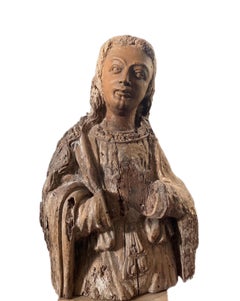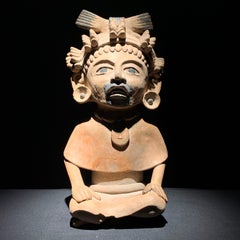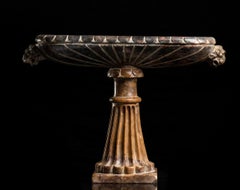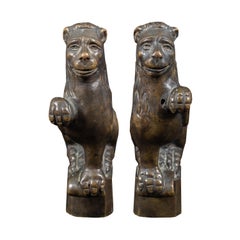18th Century and Earlier Figurative Sculptures
to
19
81
34
29
14
14
Overall Width
to
Overall Height
to
172
569
2,188
7,472
70
43
105
114
61
124
203
173
217
269
58
10
4
125
82
74
74
46
37
33
31
25
17
16
10
7
6
6
6
6
5
5
4
65
55
37
33
26
9
2
1
1
116
54
Period: 18th Century and Earlier
Gothic Renaissance wooden sculpture: bust of a young Saint or Angel
Located in Norwich, GB
This young saint or angel has suffered over the centuries, but his spirit has not been broken - and miraculously, his beautiful face has remained intact. With a gentle face and an al...
Category
Gothic 18th Century and Earlier Figurative Sculptures
Materials
Wood
Veracruz Mexico Pre-Columbian ceramic Warrior figure sculpture
Located in Wilton Manors, FL
Figure of a Chanting Warrior
Ceramic with bitumen highlights
300-600 CE (Classic Period)
Mexico, Veracruz, possibly Nopiloa
Veracruz Culture
Pre-Columbian, Mexico, Vera Cruz culture...
Category
18th Century and Earlier Figurative Sculptures
Materials
Ceramic
$6,000 Sale Price
50% Off
Pre-Columbian Colima Shaman terracotta figure vessel Mexican sculpture
Located in Wilton Manors, FL
Seated Shaman
Colima culture
Mexico
ca. 300 BCE - 300 CE
Pre-Columbian, West Mexico, Colima, ca. 300 BCE to 300 CE. A hollow-cast and highly-burnished terraco...
Category
18th Century and Earlier Figurative Sculptures
Materials
Terracotta
A large Italian Carved Africano And Giallo Antico Marble Tazza Roman Ambit 18th
Located in Roma, IT
African marble stand resting on a pedestal in antique yellow marble. The elliptical basin model decorated with radial grooves from the center outwards and with pods on the upper edge...
Category
18th Century and Earlier Figurative Sculptures
Materials
Marble
Pair of 18th century Renaissance style bronze sculptures - Lions
Located in Varmo, IT
Pair of small bronze sculptures - Grotesque lions. Italy, 18th-19th century.
10 x 5 x h 17 cm.
Made entirely of patinated bronze in Renaissance style. Depicting two seated grotesqu...
Category
Baroque 18th Century and Earlier Figurative Sculptures
Materials
Bronze
Madonna and Child, Polychrome Stucco Relief, workshop of Luca della Robbia.
Located in Pistoia, IT
Madonna and Child, polychrome stucco relief, workshop of Luca della Robbia. Second half of the 15th century.
Modeled as half-length, the Child holds his mother's veil in one hand, th...
Category
Medieval 18th Century and Earlier Figurative Sculptures
Materials
Other Medium
Medieval enthroned Virgin and Child Sedes Sapientiae acephalic granit sculpture
Located in Norwich, GB
They may be damaged and battered, but real historic objects will always give you a sense of awe. Can you sense it, looking at this ancient carved granite which depicts, as it is call...
Category
Medieval 18th Century and Earlier Figurative Sculptures
Materials
Granite
Vintage Moth I (Made-to-order, Hand-Painted, Gold Luster, Vintage Imagery)
Located in Kansas City, MO
Melanie Sherman
Vintage Moth I (Hand-Painted, Gold Luster, Vintage Imagery)
Porcelain, Glaze, Overglaze, Chinapaints, 24k German Gold Luster
Year: 2025
Size: 4.5 x 6 x 0.5 inches
Sig...
Category
Victorian 18th Century and Earlier Figurative Sculptures
Materials
Luster, Porcelain, Paint, Glaze
Baroque Italian master - 17/18th century figure sculpture - The Virgin
Located in Varmo, IT
Carved and painted wooden sculpture - Madonna in Prayer - Italy, 17th-18th century.
25 x 20 x 65 cm.
Made entirely of carved, lacquered, and painted wood. Some signs of wear and pa...
Category
Baroque 18th Century and Earlier Figurative Sculptures
Materials
Wood, Paint
$2,360 Sale Price
33% Off
Bronze bust of Seneca or Pseudo-Seneca Italy Naples late 18th-early 19th cent
Located in Pistoia, IT
Bronze bust with brown patina depicting the pseudo-Seneca, Italy, early 19th century.
The Pseudo-Seneca is a Roman bronze bust from the late 1st century B.C.. discovered in 1754 in ...
Category
Italian School 18th Century and Earlier Figurative Sculptures
Materials
Marble, Bronze
Sandstone head of Buddha, Khmer, Angkor period, post-Bayon
Located in Wilton Manors, FL
Beautiful Khmer head of Buddha. Angkor period, style of the post-Bayon. 14th century. Carved sandstone. Height 12 5/8 inches, width 5 5/8 inches, profile 5 ...
Category
18th Century and Earlier Figurative Sculptures
Materials
Sandstone
18th/19th C. Italian Alabaster Sculpture of Infant Hercules Wrestling a Snake
Located in Beachwood, OH
18th/19th Century Italian
Infant Hercules Wrestling a Snake
Alabaster
18 x 18 x 6 inches
40 lb.
In Greek mythology, the infant Hercules (Heracles) is famously depicted wrestling wit...
Category
Italian School 18th Century and Earlier Figurative Sculptures
Materials
Alabaster
After Giambologna Bronze of Mercury with green patina
By Giambologna
Located in New York, NY
Mercury, circa 1700s. Bronze with green patina. Height with base: 58 cm (22 7/8 in.)
Category
Baroque 18th Century and Earlier Figurative Sculptures
Materials
Bronze
Costa Rican pre-Columbian sculptural figure ca. 1000-1500
Located in Wilton Manors, FL
Magnificent standing figure, Costa Rica, ca. 1000-1500. Carved volcanic stone. Measures 16.5 x 9 x 5.5 inches. Outstanding condition with no damage.
The figure represents a captured...
Category
18th Century and Earlier Figurative Sculptures
Materials
Stone
18th Century French Terra Cotta Bust of a Young Gentleman
Located in Beachwood, OH
18th Century French Terra Cotta
Bust of a Young Gentleman
Terra Cotta
Unsigned
25 x 18 x 10 inches
41 lb.
Category
18th Century and Earlier Figurative Sculptures
Materials
Terracotta
Terracotta Bust of a Young Gentleman, Late 18th Century French Sculpture
Located in Beachwood, OH
After Philippe-Laurent Roland (French, 1746-1816)
Bust of a Young Man, 1772
Terra cotta set on painted wood pedestal
Signed and dated at back
16.5 x 11 x 8 inches
Philippe-Laurent R...
Category
18th Century and Earlier Figurative Sculptures
Materials
Terracotta
Late 15th-century Old Master Burgundian Netherlands carved walnut figure
Located in Wilton Manors, FL
Beautiful late 15th-century Burgundian Netherlandish portrait of a woman. Carved walnut. Original polychrome has been removed with traces at base and lower portions of figure. Minor ...
Category
Old Masters 18th Century and Earlier Figurative Sculptures
Materials
Walnut
Large Italian Neoclassical Marble Sculpture Allegory 18th century
Located in Pistoia, IT
Impressive neoclassical Carrara marble sculpture depicting the Allegory of Friendship and Loyalty, second half of the 18th century.
The sculpture depicts Friendship as a classical ...
Category
Italian School 18th Century and Earlier Figurative Sculptures
Materials
Marble
Antique Bust of Roman Emperor Vitellius
Located in Los Angeles, CA
Substantial, hand carved, solid marble bust of Roman Emperor Vitellius (24-69 C.E.) on a custom, iron base. Likely a 16th century copy of a 2nd century o...
Category
18th Century and Earlier Figurative Sculptures
Materials
Marble
Corpus Christi
Located in Wien, Wien
MUSEUM CORPUS CHRISTI
Spain/Catalonia or Asturias
Around 1250
Corpus hardwood, arms softwood
Remains of the original polychrome setting
Height 109.5...
Category
18th Century and Earlier Figurative Sculptures
Materials
Wood
$48,000
Magnificent Marble Sculpture of Roman Mythological Subject Minerva 1780'
Located in Rome, IT
Finely carved mythological roman subject of Minerva in Marble Travertino . Excellent condition from an estate of Veneto.
Measurements: Statue cm 180 .
Minerva (Pallas Athena in Greek...
Category
Academic 18th Century and Earlier Figurative Sculptures
Materials
Marble
Men on a Horse Medieval Tile Gypsum Cast
Located in Slovak Republic, SK
Gypsum cast-medieval tile, inspired from Central Europe. Adjusted in a frame, ready to hang or install.
Category
Gothic 18th Century and Earlier Figurative Sculptures
Materials
Gesso
$292 Sale Price
20% Off
Romanesque Madonna - 1175/80
Located in Wien, Wien
ROMAN MADONNA
“Sedes Sapientiae”
Auvergne
Around 1175/80
Pine wood
Polychrome remains
Height 40 cm
This depiction of the Madonna is a masterfully carved, extremely early figure made...
Category
Gothic 18th Century and Earlier Figurative Sculptures
Materials
Wood
Vierge en majesté assise romane. Sedes Sapientiae.
Located in PARIS, FR
Rare Vierge romane en majesté en pierre calcaire sculptée en très haut-relief. La Vierge tient l’Enfant entre ses deux genoux dans une parfaite frontalité, une caractéristique des pr...
Category
Medieval 18th Century and Earlier Figurative Sculptures
Materials
Limestone
Baroque Roman sculptor - 17th century bronze sculpture - Mars Warrior
Located in Varmo, IT
Gilded bronze sculpture - Mars, god of War. Rome, 17th century.
9 x 9 x h 31 cm.
Entirely in cast, chiseled and gilded bronze, resting on an ebonized wooden pedestal decorated with...
Category
Baroque 18th Century and Earlier Figurative Sculptures
Materials
Bronze
$4,149 Sale Price
41% Off
Large 17th century, Sandstone Buddha Head from Thailand, Ayutthaya Kingdom
Located in SANTA FE, NM
Large Sandstone Head of Shakyamuni Buddha
Thailand (formerly Siam), Ayutthaya Kingdom
17th century
16 1/2 inches on stand, 11 1/3 without
Private collection, France.
The face is ...
Category
Other Art Style 18th Century and Earlier Figurative Sculptures
Materials
Sandstone
Apotropäische Teufelsfigur
Located in Wien, Wien
APOTROPAIC DEVIL FIGURE
Romansh
South Tyrol or Grisons
Around 1120/50
Carved pine wood
Original version
Height 151 cm
This singular figure is a demonic, devil-like figure carved fro...
Category
18th Century and Earlier Figurative Sculptures
Materials
Wood
A Lute Player Medieval Tile Gypsum Cast
Located in Slovak Republic, SK
Gypsum cast-medieval tile, inspired from Central Europe. Could be also adjusted in a frame, ready to hang or install ( price will be different).
Category
Gothic 18th Century and Earlier Figurative Sculptures
Materials
Gesso
$235 Sale Price
20% Off
Vintage Moth II (Hand-Painted, Gold Luster, Vintage Imagery)
Located in Kansas City, MO
Melanie Sherman
Vintage Moth II (Hand-Painted, Gold Luster, Vintage Imagery)
Porcelain, Glaze, Overglaze, Chinapaints, 24k German Gold Luster
Year: 2025
Size: 4.5 x 6 x 0.5 inches
Si...
Category
Victorian 18th Century and Earlier Figurative Sculptures
Materials
Luster, Porcelain, Paint, Glaze
GILT BRONZE FIGURE OF CRISTO MORTO ATTR. G DELLA PORTA, ITALIAN RENAISSANCE
Located in Milan, IT
Circle of Guglielmo Della Porta
(Porlezza, 1515 circa – Rome 1577)
CRISTO MORTO, Italy, mid 16th Century
Gilt bronze
54 x 48 cm
21 1/4 x 19 in
Provenance:
M. Barbagli Private Collec...
Category
18th Century and Earlier Figurative Sculptures
Materials
Bronze
Renaissance Italian sculptor - 16th century carved wood sculpture - Saint Robert
Located in Varmo, IT
Carved wooden sculpture - Saint Robert. Italy, 16th century.
54 x 30 x h 112 cm.
Entirely carved and painted wood with traces of polychrome and gilding.
- Inscribed on the base: "...
Category
Renaissance 18th Century and Earlier Figurative Sculptures
Materials
Wood
$3,541 Sale Price
25% Off
ANTIQUE ITALIAN 18TH CENTURY BOXWOOD SCULPTURE OF CHRIST
Located in Milan, IT
Boxwood figure of Christ
Category
18th Century and Earlier Figurative Sculptures
Materials
Wood
CRESCENT MOON MADONNA
Located in Wien, Wien
Master in the circle of Michael Pacher
(Mühlen ca. 1435 - 1498 Salzburg)
Salzburg
Around 1480
Carved limewood
Old polychrome version
Height 118 cm
This Madonna is an outstanding ex...
Category
Gothic 18th Century and Earlier Figurative Sculptures
Materials
Wood
$168,000
One on a chariot Medieval Tile Gypsum Cast
Located in Slovak Republic, SK
Gypsum cast - medieval tile, from Central Europe. Adjusted in a frame, ready to hang or install.
Category
Gothic 18th Century and Earlier Figurative Sculptures
Materials
Gesso
$265 Sale Price
27% Off
Baroque Roman sculptor - 17th century alabaster sculpture - Hercules Cerberus
Located in Varmo, IT
Alabaster sculpture - Hercules and Cerberus. Rome, 17th century.
18 x 9.5 x h 37 cm.
Made entirely of carved alabaster. Separate alabaster base, missing left foot and arm, and othe...
Category
Baroque 18th Century and Earlier Figurative Sculptures
Materials
Alabaster
A Monumental 16th Century Renaissance Carved Oak Bust of Jesus Christ
Located in Queens, NY
Magnificent and Monumental 16th Century Renaissance Carved Oak Bust of Christ, Flemish Netherlandish, C. 1550
A powerful and deeply expressive Renaissance carved oak bust of Jesus C...
Category
18th Century and Earlier Figurative Sculptures
Materials
Oak
Eighteenth-century Grand Tour marble bust of Faustina the Younger
Located in London, GB
Signed and dated: ‘F. Harwood Fecit 1764’
Collections:
Probably commissioned by Alexander Gordon, 4th Duke of Gordon (1743-1827);
Probably by descent at Gordon Castle, Banffshire to c.1948;
Possibly acquired by Bert Crowther of Syon Lodge, Middlesex;
Jacques Hollander (1940-2004);
Christie’s, 5 December 2013, lot 101;
Private collection;
Sotheby’s, 2 July 2019, lot 106
Literature:
John Preston Neale, Views of the seats of noblemen and gentlemen, in England, Wales and Scotland, London, 1822, vol.I, unpaginated.
This marble copy of an ancient bust in the Musei Capitolini usually identified as Faustina the Younger, the daughter of Antoninus Pius and future wife of Marcus Aurelius, was made in Florence by Francis Harwood in 1764. Harwood was one of the most prolific suppliers of decorative marbles for the Grand Tour market and this finely worked example demonstrates the quality of luxury goods available to travellers to Italy. So often anonymous, this unusually signed and dated example, raises questions about the status of marble copies in the period and of sculptors such as Harwood who are known principally for ornamental work.
Harwood’s origins remain obscure. He is documented living in Palazzo Zuccari with Joshua Reynolds and the Irish sculptor Simon Vierpyl at Easter 1752, he had certainly settled permanently in Florence by the following year, when he is recorded working with Joseph Wilton. He was admitted to the Florentine Academy on 12 January 1755 (as pittore Inglese, although he was described as scultore in the matriculation account). After Wilson returned to England in 1755 Harwood appears to have worked in a studio near SS. Annunziata with Giovanni Battista Piamontini who had made life-size copies of The Wrestlers and The Listening Slave for Joseph Leeson in 1754. In 1758 both sculptors were contracted to make a statue and a trophy to complete the decoration of the Porta San Gallo, Harwood completing a statue of Equality, installed the following year.
By 1760 Harwood was on the brink of his most productive period as a sculptor, producing copies of celebrated antiquities for the ever-increasing audience of Grand Tour travellers and for the domestic market in London. In 1761 Harwood met the young architect James Adam who was in Italy specifically to make contact with suppliers for Robert Adam’s burgeoning practice back in Britain. The Adams offered a remarkably cohesive design package to their clients, encompassing not just architecture, but fixtures, fittings and furniture as well. Harwood was able to supply the brothers with marbles for their new interiors. At Syon, for example, Harwood produced a full-size copy of Michelangelo’s Bacchus for the new dining room the Adams had designed for Hugh Smythson, 1st Duke of Northumberland.
Harwood seems to have also specialised in producing sets of library busts. In 1758 Charles Compton, 7th Earl of Northampton, a distinguished traveller commissioned a set of busts which remain in situ at Castle Ashby in Northamptonshire. It is perhaps no coincidence that the Adam brothers were producing designs for new interiors at Castle Ashby at this date. The set included representations of: Cicero, Julius Caesar, Marcus Aurelius, Faustina the Younger, Sappho, Seneca and Homer. Each of these busts Harwood seems to have replicated for multiple patrons, another Adam patron, Thomas Dundas...
Category
Old Masters 18th Century and Earlier Figurative Sculptures
Materials
Marble
ITALIAN RENAISSANCE MARBLE RELIEF WITH GRIFFIN
Located in Milan, IT
ITALIAN RENAISSANCE MARBLE RELIEF WITH GRIFFIN Central Italy, 16th Century
marble
42 x 28.5 x 5.5 cm
16 1/2 x 11 1/4 x 2 1/4 in
Category
18th Century and Earlier Figurative Sculptures
Materials
Marble
Vintage Peacock III (Wall Piece/Dish (hand-painted, made to order by the artist)
Located in Kansas City, MO
Melanie Sherman
Vintage Peacock III (Wall Piece/Dish (handpainted)
Porcelain, Glaze, Overglaze, Chinapaints, 24k German Gold Luster, Brass Wire (for hanging, can be removed)
Year: 2023 (and following years)
Size: 5.5x4x0.25in
Signed by hand
COA provided
Ref.: 924802-1333
*Made to Order Every piece is unique, design might differ slightly Customization possible
**Lead time approx. 2 weeks for qty 1-3
------------------------
My ceramics are handmade and painted with the finest overglazes from Europe. The gold luster used is 24k liquid Gold from Germany. Every piece is unique. My imagery is inspired by vintage Meissen dinnerware, William Morris wallpaper and other historical sources.
Porcelain, Ceramics, Pottery, Ornament
Vintage Moth Wall Piece Ornament Small Dish Candy Sugar Tea handpainted handmade butterfly peacock 24k German gold luster ceramics porcelain charm, jewelry, personalized, family, tree, retro, heart, mother, moon, baby, feet, gemstone, flower, mom, birth, year, art, chinapaint, luster, lustre, contemporary ceramics, futility of pleasure, herend, meissen, sevre, pattern, arita, arita ware, imari, imari ware, dresden, germany, japan, jingdezhen, china, photography, momento mori, flowers, flower motif, drawing, illustration, peacock, cherry blossom, chrysanthemum, kiku, 菊, kikka, 菊花, Ōka, 黄花, Kiku no hana...
Category
Baroque 18th Century and Earlier Figurative Sculptures
Materials
Brass
Italian master - 18th century figure sculpture - Virgin Pity - Carved Wood Paint
Located in Varmo, IT
Carved and painted wooden sculpture - Pietà - Italy, 18th century.
13 x 7 x h 22.5 cm.
Entirely made of carved and polychrome painted wood.
Condition report: Good state of conserv...
Category
Old Masters 18th Century and Earlier Figurative Sculptures
Materials
Paint, Wood
Limestone figure of Virgin and child, Lorraine, 14th century, French Gothic
Located in PARIS, FR
Virgin and Child with Goldfinch
Workshops of Metz, Lorraine, circa 1330
Limestone carved in the round with remains of polychromy
Height: 61 cm
The sculpture of the Virgin and Child ...
Category
Gothic 18th Century and Earlier Figurative Sculptures
Materials
Limestone
Just A Little Tipsy (MADE TO ORDER) (Sabbath, Kiddush, Unique, Gold Luster)
Located in Kansas City, MO
(MADE TO ORDER) (Sabbath, Kiddush, Unique, Gold Luster)
*Lead Time may vary between 1-3 weeks
Melanie Sherman
"Just A Little Tipsy"
Year: 2021
Porcelai...
Category
Rococo 18th Century and Earlier Figurative Sculptures
Materials
Luster, Porcelain, Glaze
A Grouping of Three Period Ancestor Posts, Possibly Aztec
Located in Chicago, IL
A Grouping of Three Period Figural Ancestor Posts; Mexican Tribal Figures, Possibly Pre-Columbian Aztec. Each are Terra cotta or sandstone with obsidian glass inlay to the eyes; Da...
Category
Tribal 18th Century and Earlier Figurative Sculptures
Materials
Sandstone
Roman Carrara Marble Lioness
Located in Los Angeles, CA
Magnificent hand carved Carrara marble sculpture of a lioness head from Rome. Mounted on a metal base. Base 13.75"W x 12.25"D.
Category
18th Century and Earlier Figurative Sculptures
Materials
Marble, Metal
Baroque Italian master - 17/18th century figure sculpture - Saint
Located in Varmo, IT
Carved and painted wooden sculpture - Figure of a saint - Italy, 17th-18th century.
36 x 25 x 74 cm.
Made entirely of carved, lacquered, and painted wood. Some signs of wear and pa...
Category
Baroque 18th Century and Earlier Figurative Sculptures
Materials
Wood, Paint
$2,951 Sale Price
28% Off
18th Century Italian Carved Neoclassical Semi Nude Female Busts
Located in Beachwood, OH
18th Century Italian Carved Neoclassical Semi Nude Female Busts
Wood affixed to wood plinths
"Leone Della Torra / Italy Country of Origin" labels on b...
Category
Italian School 18th Century and Earlier Figurative Sculptures
Materials
Wood
Wooden Sculptures Roman Soldiers Rome 18th Century Italy Art Gold
Located in Riva del Garda, IT
Wooden sculptures depicting a pair of full-length Roman soldiers
Rome, 18th century
Carved and gilded wood (walnut?)
Dimensions: Maximum height (at lance) 62 cm./ Maximum width: 28 ...
Category
Old Masters 18th Century and Earlier Figurative Sculptures
Materials
Gold
$6,434 Sale Price
20% Off
Group of four 18th century Venetian wooden sculptures - Singer and musicians
Located in Varmo, IT
Four table sculptures - Concertino with musicians and singer. Venice, late 18th century.
9 x 7 x h 20 cm each.
Entirely in wood, finely carved and painted in polychrome.
Condition...
Category
Rococo 18th Century and Earlier Figurative Sculptures
Materials
Wood, Paint
$2,370 Sale Price
20% Off
ANCIENT ROMAN BRONZE SCULPTURE FIGURE OF A ROMPING DOG
Located in Milan, IT
"Roman Bronze Figure Of A Romping Dog"
Roman Empire, circa 1st Century B.C.- 1st Century A.D.
Bronze
width 7 cm
width 2 3/4 in
Provenance:
Leo Mildenberg (1913-2001) Private Collection, Zurich, prior to 1986
American Private Collection, acquired in 1991
Literature:
A.P. Kozloff, et al., More Animals in Ancient Art...
Category
18th Century and Earlier Figurative Sculptures
Materials
Bronze
Agnus dei - Puerta de sagrario - Siglo XVII
Located in Sant Celoni, ES
Muy interesante puerta de sagrario de madera tallada y policromada del siglo xvii.
Es de comienzos del barroco, hay la representación del agnus dei con...
Category
Baroque 18th Century and Earlier Figurative Sculptures
Materials
Wood Panel
$1,138 Sale Price
20% Off
Marble head of Roman Emperor Tiberius
Located in New York, NY
Antique marble head of the roman emperor Tiberius. 43cm without the base. 18th Century.
Category
18th Century and Earlier Figurative Sculptures
Materials
Marble
ANCIENT ROMAN ALABASTER BUST OF THE GOD SERAPIS, ROME CIRCA 1ST-2ND CENTURY A.D.
Located in Milan, IT
Wearing a chiton with a himation draped at the left shoulder, and a modius on the crown of his head, the god's characteristic luxuriant wavy hair falling in ri...
Category
18th Century and Earlier Figurative Sculptures
Materials
Alabaster
Just A Little Tipsy (MADE TO ORDER) (Sabbath, Kiddush, Unique, Gold Luster)
Located in Kansas City, MO
(MADE TO ORDER) (Sabbath, Kiddush, Unique, Gold Luster)
*Lead Time may vary between 1-3 weeks
Melanie Sherman
"Just A Little Tipsy"
Year: 2021
Porcelai...
Category
Rococo 18th Century and Earlier Figurative Sculptures
Materials
Luster, Porcelain, Glaze
Sancai-Glazed Horse with Cut Fur Blanket
Located in Palm Desert, CA
A Chinese, Tang Dynasty, Sancai-glazed, three colors of brown, green and creamy, sculpture of a horse with a cut fur blanket. This Chinese, Tang Dynasty (618-907 AD), glazed earthenw...
Category
18th Century and Earlier Figurative Sculptures
Materials
Earthenware, Glaze
Panel in Scagliola Manifattura Carpigiana mid-17th century "St. Michael"
Located in Pistoia, IT
Carpi, mid-17th century, scagliola panel.
The panel, in black and white two-tone, features insertions of polychrome marbled elements and a central scene depicting St. Michael defeat...
Category
Baroque 18th Century and Earlier Figurative Sculptures
Materials
Slate
Perseus
Located in New Orleans, LA
The legendary Greek god Perseus is the subject of this elegant half-bust by Ubaldo Gandolfi, a major painter and sculptor from Bologna. The son of Zeus and Danaë, Perseus was the le...
Category
Other Art Style 18th Century and Earlier Figurative Sculptures
Materials
Terracotta
Renaissance Era Marble Figure Fragment
Located in Los Angeles, CA
An extraordinary 17th century, hand-carved, solid Carrara marble, life sized figure fragment on raised base of the same. The subject is swaddled in a luxurious, gathered robe and tun...
Category
Baroque 18th Century and Earlier Figurative Sculptures
Materials
Marble
Just A Little Tipsy (MADE TO ORDER) (Sabbath, Kiddush, Unique, Gold Luster)
Located in Kansas City, MO
(MADE TO ORDER) (Sabbath, Kiddush, Unique, Gold Luster)
*Lead Time may vary between 1-3 weeks
Melanie Sherman
"Just A Little Tipsy"
Year: 2021
Porcelain, Glaze, ChinaPaint, 24k Germ...
Category
Baroque 18th Century and Earlier Figurative Sculptures
Materials
Luster, Porcelain, Glaze
Corpus Christi 1150/70
Located in Wien, Wien
Corpus Christi
around 1150/70
Southern France or Catalonia
carved oak wood
height 109 cm, width 96 cm
Remains of polychromy
Category
Gothic 18th Century and Earlier Figurative Sculptures
Materials
Wood
$280,000
ANCIENT ROMAN MARBLE RELIEF FRAGMENT
Located in Milan, IT
ANCIENT ROMAN MARBLE RELIEF FRAGMENT
Rome, 1st Century b.C.
marble
23 x 15 x 5 cm without base
9 x 6 x 2 in
Category
18th Century and Earlier Figurative Sculptures
Materials
Marble



